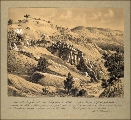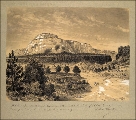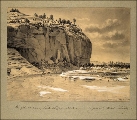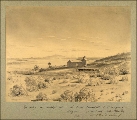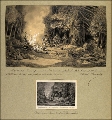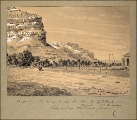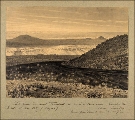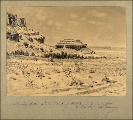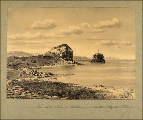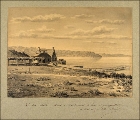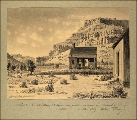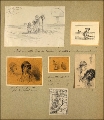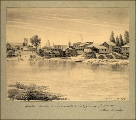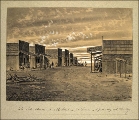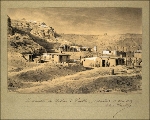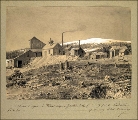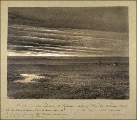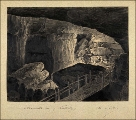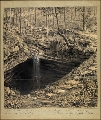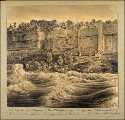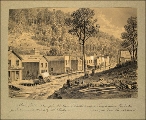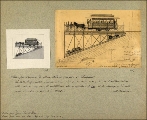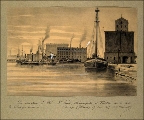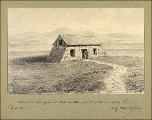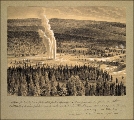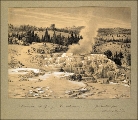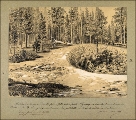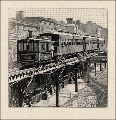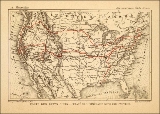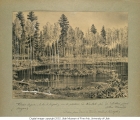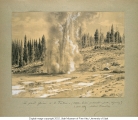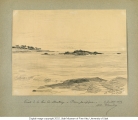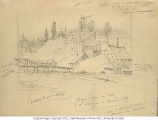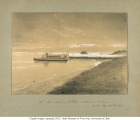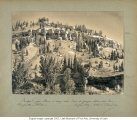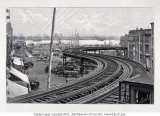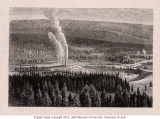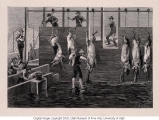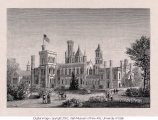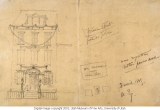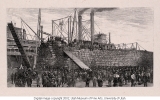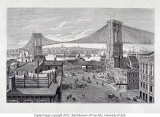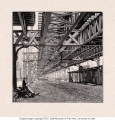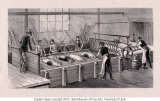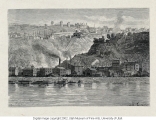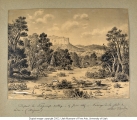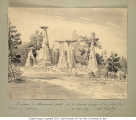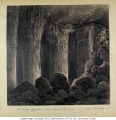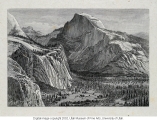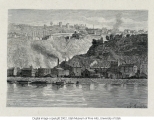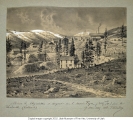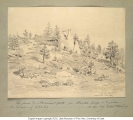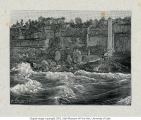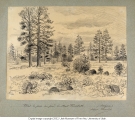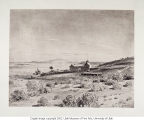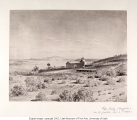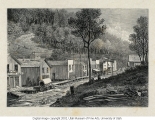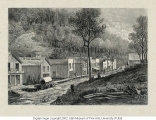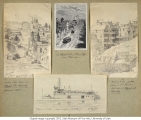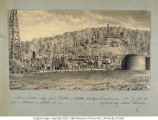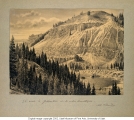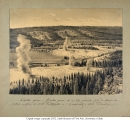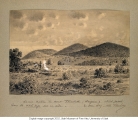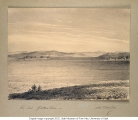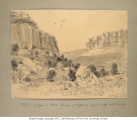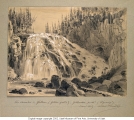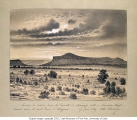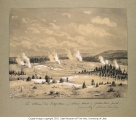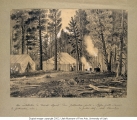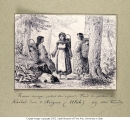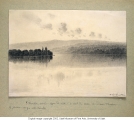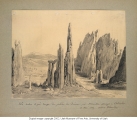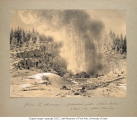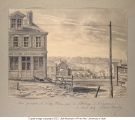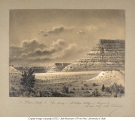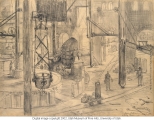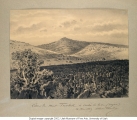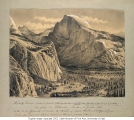| Identifier |
1978_201_coloredSands.jpg |
| Title |
The Green Sandstone Sands near Panguitch, Utah |
| Alternate Title |
Les sables de grès vert près Panguitch (Utah) |
| Artist's Notation |
"1er plan grès violacé cremeux très clair - petites pierres (violet foncé) grès vert foncé et vert clair - Les murailles du fond sont blanches et rouges, couleurs vives et très nettes. Dessin paru dans la Nature." |
| Creator |
Tissandier, Albert 1839-1906 |
| Subject |
Landscape drawings--1880-1890 |
| Published Location |
This image, engraved by E. A. Tilly, was published in La Nature, no 665 (27 Feb 1886), as figure 1 (p. 200), to accompany the fifth installment of Albert Tissandier's "Lettres d'Amérique", with the caption "Sable de grès vert, près de Panguitch, dans l'Utah. D'après nature, par M. Albert Tissandier (22 juin 1885)." http://cnum.cnam.fr/CGI/fpage.cgi?4KY28.26/204/100/432/0/0 The same image appears as figure 27 (p. [105]), engraved by E. A. Tilly, in Albert Tissandier's book Six mois aux États-Unis : voyage d'un touriste dans l'Amérique du nord suivi d'une excursion à Panama (Paris : G. Masson, [1886]), with the caption "Les grès verts près Panguitch (Utah), (d'après nature)". Associated text (p. 103): "Nous nous engageons bientôt dans la montagne. Au milieu de terrains de grès vert, presque vert pomme, se dressent une quantité de rochers de même matière. Ils forment de hautes collines dénudées et sans consistance. Les orages et les neiges de l'hiver, en fondant, tracent mille ruisseaux le long de ces hauts talus et les déforment d'une manière bizarre dans tous les sens. Une quantité de pierres en forme de rognons restent souvent sur le sommet de petites buttes de grès qui s'éboulent peu à peu. On ne saurait imaginer de lieux plus singuliers, et je ne pouvais cesser de m'étonner de la couleur verte des roches des premiers plans, en opposition avec les murailles roses couronnées de forêts qui fermaient l'horizon (fig. 27). En ce moment même, à Paris, je me demande si réellement je n'ai pas rêvé ce que j'ai dessiné et ce que je viens d'essayer de décrire." |
| Short Essay |
"We soon entered into the mountains. In the middle of the terrain of green sandstone, almost apple-green, a quantity of rocks of the same material rose up. They form high hills, bare and without consistency. The storm and winter snows, when melting, trace thousands of streams along these high slopes and deform them in a bizarre manner in every sense. A quantity of kidney-shaped stones often rest on the top of little sandstone buttes which crumble away little by little. You cannot imagine a more unusual place and I was ceaselessly amazed at the green color of the rocks in the foreground, in opposition to the pink walls crowned by forests along the horizon." This excerpt from Tissandier's journal, along with his detailed drawing, clearly indicates how captivated he was with the unusual landscape of Panguitch, Utah. His drawing is a careful rendition of the abstract formations of the sandstones of Panguitch, and is informed by the specific description of the colors in his journal. Tissandier described the unique colors by discussing combinations of two or three hues as when he identifies the color of the sand as grey-green. The sparse landscape is only slightly relieved by the cluster of hardened sand formations that dominate the center of the composition. These formations are the result of thousands of years of rain and wind that have carved away the weaker sections of the stratus leaving surfaces of grooves and rounded sandstone. Two figures and a horse occupy the space near the central element, perhaps to establish scale in contrasting figures with landscape. Without the human figures as references, the formations would appear larger. The drawing is a carefully detailed rendering of the variety of textures of the landscape around Panguitch. The foreground sand is fine, soft and dry, the sandstone formation is smooth and delicate, and the shrubs seem healthy in spite of extremely arid conditions. |
| Publisher |
Utah Museum of Fine Arts |
| Contributors |
Mary F. Francey |
| Date |
1885-06-22 |
| Type |
Image |
| Format |
application/pdf |
| Source |
Albert Tissandier: Drawings of Nature and Industry in the United States |
| Language |
fra |
| Rights Management |
Digital image c2001 Utah Museum of Fine Arts, University of Utah |
| Source Physical Dimensions |
35.56 cm High x 40.64 cm Wide |
| Source Characteristics |
Graphite and brush applied ink on paper |
| Light Source |
Kaiser Softlite ProVision 6x55W flourescent 5400K daylight |
| Archival Resolution |
TIFF: 5039 x 4250 pixels |
| Display Resolution |
JPEG: 900 x 819 pixels |
| Bit Depth |
36-bit color |
| Scanning Device |
Leica S1 Pro scanning camera; Hasselblad CFi 50mm F/4 lens; f/11 |
| Exhibit Catalog |
ISBN: 0-9657215-0-7; Library of Congress Catalog Number: 2001094211 |
| Setname |
uu_umfa_at |
| ID |
415787 |
| Reference URL |
https://collections.lib.utah.edu/ark:/87278/s6bk1cds/415787 |

